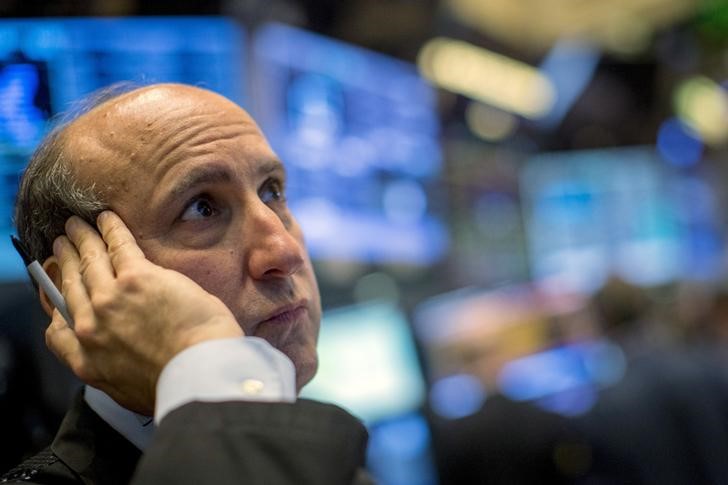By Jamie McGeever
ORLANDO, Florida (Reuters) -U.S. equity market concentration is, by some measures, now the strongest ever, raising justifiable concerns that having the entire market’s fate in the hands of so few stocks will only end in tears.
The current environment highlights a lack of diversification and risk-spreading options, fuels bubble speculation, and makes it difficult for active and even passive managers to beat the benchmark index when the juggernaut is being driven by literally a handful of stocks.
But it’s not necessarily an accident waiting to happen.
From a global historical perspective Wall Street’s dynamics today are not without precedent, average returns tend to be higher when concentration is rising rather than falling, and the ongoing tech-led boom is supported by strong fundamentals.
These are the conclusions, amongst others, in a deep-dive analysis into market concentration published last week by Michael J. Mauboussin and Dan Callahan at Morgan Stanley Investment Management.
Remarkable as it may seem, at the end of last year the U.S. equity market was nowhere near the most concentrated among leading global equity markets.
Out of a dozen of the world’s largest, the U.S. market was the fourth least concentrated, with the top 10 U.S. stocks accounting for almost 30% of national market cap. Only India, Japan and China were less concentrated, by that measure, while concentration was most extreme in Switzerland, France and Australia.
America’s position in that list will have changed since, in light of the ongoing artificial intelligence and tech boom, particularly in Nvidia (NASDAQ:) shares. Analysts say the top 10 stocks now account for a record 35% of U.S. market cap.
But it does put the current U.S. picture into a wider context.
Mauboussin and Callahan note a 2020 study that found that, across 47 equity markets around the world between 1989 and 2011, the average weighting of the top 10 stocks was 48%. That paper was by no means singing the praises of narrow markets, but again, it puts the current frenzy over Wall Street’s narrowness into a less alarming historical context.
“The U.S. stock market, even after a decade of increasing concentration, remains one of the more diversified markets in the world,” Mauboussin and Callahan wrote.
Of course, the top one, three or 10 U.S. stocks matter much more for the world than the equivalent issues anywhere else – the market cap of U.S. stocks last year was around 60% of global equity market cap, and is no doubt even higher now.
FEATURE, NOT A BUG
Of all the eye-popping statistics currently being bandied around about the scale of market concentration, Howard Silverblatt, senior index analyst at S&P Dow Jones Indices, provides perhaps the most remarkable.
He notes that the top three U.S. companies Apple (NASDAQ:), Nvidia and Microsoft (NASDAQ:) account for 10.6% of global market cap.
But is that strength justified? It might well be.
Mauboussin and Callahan estimate that in the decade from 2014 to 2023, the top 10 U.S. stocks’ market cap averaged 19% but their share of overall U.S. earnings was 47%. Last year, their market cap and share of overall profits rose to 27% and 69%, respectively.
Silverblatt calculates that Nvidia, whose shares are up more than 140% this year, accounts for a third of the ‘s entire total returns of 13% year to date.
“Concentration is extremely high now, unusually high. But when these companies are doing well, you’re a happy camper,” he says.
Indeed, Mauboussin and Callahan find that since 1950, the S&P 500 has delivered above-average returns in periods when concentration was rising and below-average returns when concentration was falling.
The results surrounding the late 1990s dotcom boom and 2000 bust may be particularly resonant given the tech-centric nature of today’s market concentration – compound annual returns in the 1994-1999 years were 23.5%, and just 3.6% from 2000 to 2013.
Admittedly, that latter period includes the Great Financial Crisis, but it is an insight into what can happen when concentration in a tech-heavy market dissipates. Be careful what you wish for?
While the current concentration of wealth, earnings and market cap in the hands of so few stocks is unprecedented by many measures, increased concentration appears to be a feature of the U.S. stock market, not a bug.
A study last year titled ‘Shareholder Wealth Enhancement, 1926 to 2022’ by Hendrik Bessembinder, professor of finance at Arizona State University, showed that the trend of increasing concentration has been in place for decades.
What’s more, in the internet-based economy that has created more ‘winner take all’ outcomes, it is increasing.
Bessembinder finds that investments in publicly listed U.S. stocks enhanced shareholder wealth (SWC) by more than $55 trillion in aggregate from 1926 to 2022 even as investments in more than half – 58.6% of the 28,114 individual stocks – reduced shareholder wealth.
The Top 11 firms account for slightly over 20% of net SWC, the top 23 firms account for just over 30%, and the top 42 firms account for just over 40%.
The number of companies that account for half of total net wealth creation since 1926 decreased from 90 in 2016, to 83 in 2019, and to 72 as of 2022, Bessembinder notes.
“It can be anticipated that shareholder wealth creation is likely to be concentrated in a relatively few firms during future decades as well,” he concludes.
(The opinions expressed here are those of the author, a columnist for Reuters.)
(By Jamie McGeever; Editing by Andrea Ricci)
Read the full article here
















